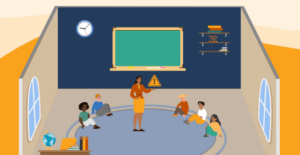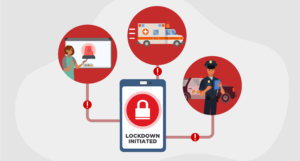Although school shootings are relatively rare, it’s imperative that schools and everyone inside of them know exactly what to do in an active shooter situation. Training, which includes conducting drills, helps teachers, students, and staff respond to the emergency and ultimately save lives.
These top 5 considerations are based on recommendations and best practices from various school safety experts, including the National Association of School Resources Officers (NASRO), the Partner Alliance for Safer Schools (PASS), and Safe Kids, Inc., as well as conversations Raptor has had with over 34,000 K-12 schools. By considering these recommendations, schools can better ensure that their active shooter training is effective and safe for all students and staff.
1. Ensure the Curriculum is Appropriate for Every Student
Active shooter training should include evidence-based, age-appropriate curriculum that gives teachers and students the confidence to respond to any kind of violence. The lessons should be teacher-led, interactive, adaptable, problem-based, and developed with school safety and mental health professionals to ensure each lesson is appropriate for the grade level. For example, using a fictional picture book to demonstrate how characters stay safe is appropriate for younger students, whereas collaborative, table-top exercises are appropriate for older students. It’s critical that schools also have lesson plans for students with disabilities. This includes students with hearing impairments, sensory processing issues, or intellectual disabilities, and students with autism or those who use wheelchairs. The lessons plans should also be reviewed and updated annually to ensure they incorporate the latest exercises and best practices.
2. Practice the Curriculum with Thoroughly Planned Drills
Schools should conduct drills in an educational way to practice and test procedures, processes, and technologies, and to build muscle memory and improve overall response. Drills should be part of your emergency operations plan (EOP) and developed in partnership with first responders, mental health professionals, and safety team members. It’s important to tailor drills to your specific school environment and developmental levels of participants. Schools should also announce drills ahead of time, as well as have an announcement when the drill begins (e.g. This is a drill, not an actual emergency) to decrease the likelihood of someone thinking theres a real threat. Unannounced or surprise drills can traumatize participants. As a result of this surprise drill, for example, students sent their parents goodbye messages after the school failed to mention the code red and automated texts about an active shooter on campus were just part of a drill.
3. Build Confidence, Not Fear
Schools should not have realistic simulations that invoke fear, trauma, or stress. Examples of realistic simulations that schools have used include firing blank rounds of ammunition; having strangers in masks trying to enter locked classrooms; using special effects like smoke or fog to cloud the hallways; covering students with fake blood; and having police in full tactical gear with weapons storm the rooms. In some instances, parents have signed petitions to stop the use of realistic simulations and students and staff have opted-out of participating. In August 2020, teachers filed a lawsuit after an active shooter training, where they were shot at point-blank range with an air-soft gun, left them with physical injuries and mental health issues. Drills that use realistic simulations can potentially traumatize students, staff, and teachers by triggering past trauma or scaring participants so significantly that new trauma is developed.
4. Have a Comprehensive Approach to School Safety
Schools should take a balanced, holistic, and robust approach to school safety that involves multidisciplinary planning and implementation. Active shooter training, and the drills that go along with it, are only one component. A comprehensive EOP that outlines how your school will prepare for, respond to, and recover from emergencies is critical. It’s important to consider how your EOP and emergency processes impact each of your students, teachers, and staff members and to ensure that your processes follow best practices and are effective and safe for everyone involved.
5. Partner with Industry Experts to Ensure Success
Consider a partner who can help you establish a comprehensive approach to school safety, including processes and technology for preparing for, responding to, and recovering from any emergency. Raptor Emergency Management empowers schools to summon help immediately with a silent panic button and maintain real-time visibility during drills, active incidents, and reunification events. To teach students how to prevent and survive active shooter incidents, Raptor has partnered with Safe Kids, Inc. to provide Raptor customers with a no-cost, 1-school year subscription to the Safe Kids H.E.R.O. training curriculum that has simple, easy-to-remember, and truly effective strategies. Used by over 100,000 students across the U.S., the H.E.R.O. Program includes age-appropriate student-facing curriculum, professional development for staff, drill and scenario guides, an accessibility guide for students with special needs, and other materials specific to violence prevention.
This offer is available for current Raptor customers that use at least one of the following solutions: Raptor Visitor Management, Raptor Emergency Management, or Raptor Volunteer Management. Current Raptor customers can fill out this form to get started. Not a current customer? Request a demo online to learn more about Raptor solutions.



